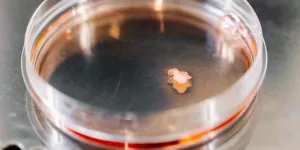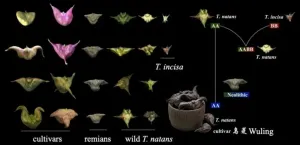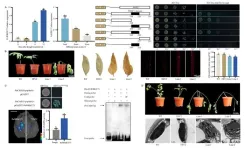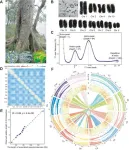(Press-News.org) A lot of research has been done over many decades on diseases that are widespread in large parts of the population, such as cancer and heart disease. As a result, treatment methods have improved enormously thanks to long-term research efforts on diseases that affect many people.
However, there are many diseases that affect just a handful people. These diseases often fly under the radar and are far less researched. They include quite a few rare, hereditary diseases, such as DOOR syndrome, which is especially found in Canada and the Middle East.
A team of scientists is now in the process of trying to change this.
“For some hereditary, rare diseases, there is currently no cure. However, gene therapy is a possible solution, and we are now testing various strategies using gene therapy,” says Magnar Bjørås, a professor at the Norwegian University of Science and Technology (NTNU's) Department of Clinical and Molecular Medicine.
He has established a research team at NTNU and Oslo University Hospital that conducts basic research on rare, hereditary diseases with a long-term goal of finding new therapies.
Brain cells become dysfunctional or die
One of the rare diseases for which there is currently no medication or treatment is called DOOR syndrome.
This is a congenital disorder that involves multiple abnormalities. DOOR is an acronym for the main features of the disorder: Deafness, Onychodystrophy (short or absent nails), Osteodystrophy (short fingers and toes) and developmental delay and intellectual disability (previously called mental Retardation).
DOOR syndrome is hereditary and is caused by the lack of a specific protein in the genes called OXR1 (OXidation Resistance gene 1).
“Due to lack of this protein, the brain cells are unable to develop as they should. As a result, the brain cells either become dysfunctional or simply die,” says Magnar Bjørås.
In order to investigate whether there is a way to prevent this from happening, the Bjørås team has carried out tests inside mini-brains that they grow in their lab.
From skin cells to mini-organs
The Bjørås team has been working on growing mini-organs such as mini-brains, mini-lungs and mini-eyes since 2018. The scientists use the mini-organs to test drugs and gene therapy.
In order to grow mini-brains for their research on DOOR syndrome, the research team needed cells from people who have this disease.
A number of cases have been registered in Canada and the Middle East, and the research being done in Norway is based on skin cells from people who have DOOR syndrome.
“In the laboratory, we have transformed the skin cells into embryo cells. We have reversed the development in the skin cells so that they return to the foetal stage and become like the first cells that form in humans. We have then used these stem cells to create mini-brains,” says Bjørås.
Using skin cells from people with DOOR syndrome, the scientists have recreated the disease in the mini-brains. They can then use these mini-brains to test out therapies for this disease.
The process of developing mini-brains takes several months and is painstaking and expensive.
Starting production of the missing protein
The work has given the scientists insight into the reasons why patients develop disease – and thus also ideas for treatment strategies. Gene therapy is one possible treatment where the brain cells can be made to start producing the missing protein.
A virus is actually used as a messenger that delivers the necessary production information to the brain cells.
“As a follow-up to our published work, we are now testing virus-based gene therapy as a treatment for this disease," Bjørås said. "We create a harmless virus in the lab and then put a healthy OXR1 gene into the virus’ genome, and this gene has the ability to produce the protein that brain cells lack in people with DOOR syndrome."
Can stop the disease
The virus is then injected into the mini-brains.
“The virus is absorbed into the brain and brain cells. The gene introduced into the brain cells via the virus can then begin to produce the missing protein," he said. "If this protein can be overproduced, it helps to stop and, at best, reverse the disease. In order to treat DOOR syndrome, patients will need to start gene therapy at a very early stage, probably as soon as the first symptoms of disease are noticed."
Gene therapy research has evolved greatly over the past 20 years.
“In 2007, only one clinical trial of gene therapy took place. Today, there are thousands of clinical trials involving gene therapy,” Bjørås said.
Leading the way in treating other hereditary diseases
The research has not only provided new knowledge and ideas for the treatment of patients with DOOR syndrome, but also for other diseases.
“What is particularly interesting about the OXR1 protein that patients with DOOR syndrome lack is that this gene therapy method also has an interesting potential for treating other diseases,” says Bjørås.
The OXR1 protein reduces inflammation, which is a characteristic of most degenerative diseases of the brain, such as childhood dementia, Alzheimer’s, ALS and Parkinson’s.
Studying brain development
The researchers have used new, advanced technology. The mini-brains that they have grown are made from skin cells from DOOR syndrome patients and from healthy individuals.
The mini-brains have been used to study brain development and the scientists have created different parts of the brain that control different functions, such as memory, learning, motor skills, fluid balance, hormone balance and temperature control.
It has been shown for the first time in a human model that OXR1 promotes protein methylation during brain development in space and time. Protein methylation is one of several important chemical processes that control gene expression.
The study provides new insights into pathological traits associated with OXR1 deficiency in patients.
References: Genome Biology. A loss-of-function mutation in human Oxidation Resistance 1 disrupts the spatial–temporal regulation of histone arginine methylation in neurodevelopment
https://genomebiology.biomedcentral.com/articles/10.1186/s13059-023-03037-1
END
New therapy can treat rare and hereditary diseases
Using mini organs and other cutting edge research, researchers are finding clues that may enable them to treat rare and deadly diseases.
2023-11-23
ELSE PRESS RELEASES FROM THIS DATE:
Y-chromosome and its impact on digestive diseases
2023-11-23
A major breakthrough in human genetics has been achieved with the complete decoding of the human Y chromosome, opening up new avenues for research into digestive diseases. This milestone, along with advancements in third-generation sequencing technologies, is poised to revolutionize our understanding of the genetic underpinnings of digestive disorders and pave the way for more personalized and effective treatment strategies.
The Y chromosome, the smallest of the human chromosomes, has long been shrouded in mystery due to its complex repetitive structure. However, recent advancements in sequencing technologies have enabled researchers to unravel the intricate details of this genetic ...
Fractional COVID-19 booster vaccines produce similar immune response as full-doses
2023-11-23
Reducing the dose of a widely used COVID-19 booster vaccine produces a similar immune response in adults to a full-dose with fewer side effects, according to a new study.
The research, led by Murdoch Children's Research Institute (MCRI) and the National Centre for Communicable Diseases in Mongolia, found that a half dose of a Pfizer COVID-19 booster vaccine elicited a non-inferior immune response to a full dose in Mongolian adults who previously had AstraZeneca or Sinopharm COVID-19 shots. But it found half-dose boosting may be less effective in adults primed with the Sputnik V COVID-19 vaccine.
The research ...
Consolidator Grants: ERC unleashes €627 million in grants to fuel excellent research across Europe
2023-11-23
Iliana Ivanova, European Commissioner for Innovation, Research, Culture, Education and Youth, said: “I extend my heartfelt congratulations to all the brilliant researchers who have been selected for ERC Consolidator Grants. I'm especially thrilled to note the significant increase in the representation of women among the winners for the third consecutive year in this prestigious grant competition. This positive trend not only reflects the outstanding contributions of women researchers but also highlights the strides we are making towards a more inclusive and diverse scientific community.”
President of the European Research Council Prof. Maria Leptin said: “The new ...
A fifth higher: Tropical cyclones substantially raise the Social Cost of Carbon
2023-11-23
Extreme events like tropical cyclones have immediate impacts, but also long-term implications for societies. A new study published in the journal Nature Communications now finds: Accounting for the long-term impacts of these storms raises the global Social Cost of Carbon by more than 20 percent, compared to the estimates currently used for policy evaluations. This increase is mainly driven by the projected rise of tropical-cyclone damages to the major economies of India, USA, China, Taiwan, and Japan under global warming.
“Intense tropical cyclones have the power to slow down the economic development of a country for more than a decade, our analysis shows. With global warming, the share ...
Study reveals how shipwrecks are providing a refuge for marine life
2023-11-23
An estimated 50,000 shipwrecks can be found around the UK’s coastline and have been acting as a hidden refuge for fish, corals and other marine species in areas still open to destructive bottom towed fishing, a new study has shown.
Many of these wrecks have been lying on the seabed for well over a century, and have served as a deterrent to fishers who use bottom towed trawling to secure their catches.
As a result, while many areas of the seabed have been damaged significantly in areas of heavy fishing pressure, the ...
Pangenomic study of water caltrop — structural variations play a role in speciation and asymmetric subgenome evolution
2023-11-23
Rice, maize, and wheat provide more than half of the calories consumed by humans. The decrease in crop diversity poses a significant risk to global food security. Therefore, the utilization of orphan crops has become an effective approach to address food security crises. Nevertheless, in the face of rapid urban and rural modernization and the intensification of agricultural practices, the availability of wild and cultivated orphan crops is dwindling, with a noticeable disparity in their collection, preservation, ...
Professor Tao Jun's team at Yangzhou University analyses the molecular mechanism of PoWRKY71 in response to drought stress of Paeonia ostii
2023-11-23
Paeonia ostii is a widely grown woody crop with up to 40% α-linolenic acid in its seed oil, which is beneficial to human health. Drought is a major environmental factor limiting the popularisation of P. ostii in hilly and mountainous areas, which may affect plant growth or lead to plant death.WRKY is one of the largest families of transcription factors in plants, and plays an important role in plant response to drought stress. However, the molecular mechanism by which P. ostii WRKY transcription factors respond to drought stress is still unclear.
In September 2023, Horticulture ...
The Chinese team completed the genome assembly of Cornus wilsoniana
2023-11-23
Cornus wilsoniana (2n=22) is a common shrub in the northern temperate zone of China. It blooms white flowers in spring and produces purple-black berries in autumn. This tree has a unique mottled bark texture that makes it particularly eye-catching in winter, earning it the common name "ghost dogwood". Due to its peeling bark in winter, it is commonly known as "Guangpi tree" in China. The fruit of C. wilsoniana is rich in oil and can be used to extract edible oil. The oil content ...
Does patient-surgeon gender concordance lead to lower patient mortality? Mostly no, UCLA-led research suggests
2023-11-23
Does patient-surgeon gender concordance lead to lower patient mortality? Mostly no, UCLA-led research suggests
New research finds little evidence that post-surgical patient mortality is lower when patient and surgeon are the same gender.
While gender concordance has been shown to improve patient care in other health specialties, evidence has been limited when it comes to concordance between patient and surgeon. This study shows that gender concordance was associated with lower mortality for female patients, but higher mortality for male patients—patient mortality was the lowest for ...
Drones enabled the use of defibrillators before ambulance arrival
2023-11-23
Researchers at Karolinska Institutet have evaluated the possibility of alerting drones equipped with automated external defibrillators (AED) to patients with suspected cardiac arrest. In more than half of the cases, the drones were ahead of the ambulance by an average of three minutes. In cases where the patient was in cardiac arrest, the drone-delivered defibrillator was used in a majority of cases. The results have been published in the journal The Lancet Digital Health.
"The use of an AED is the single most important factor in saving lives. We have been deploying drones equipped with AED since the summer ...
LAST 30 PRESS RELEASES:
NTIDE: Disability employment holds steady after data hiatus
Social lives of viruses affect antiviral resistance
Dose of psilocybin, dash of rabies point to treatment for depression
Helping health care providers navigate social, political, and legal barriers to patient care
Barrow Neurological Institute, University of Calgary study urges “major change” to migraine treatment in Emergency Departments
Using smartphones to improve disaster search and rescue
Robust new photocatalyst paves the way for cleaner hydrogen peroxide production and greener chemical manufacturing
Ultrafast material captures toxic PFAS at record speed and capacity
Plant phenolic acids supercharge old antibiotics against multidrug resistant E. coli
UNC-Chapel Hill study shows AI can dramatically speed up digitizing natural history collections
OYE Therapeutics closes $5M convertible note round, advancing toward clinical development
Membrane ‘neighborhood’ helps transporter protein regulate cell signaling
Naval aviator turned NPS doctoral student earns national recognition for applied quantum research
Astronomers watch stars explode in real time through new images
Carbon-negative building material developed at Worcester Polytechnic Institute published in matter
Free radicals caught in the act with slow spectroscopy
New research highlights Syntax Bio’s platform for simple yet powerful programming of human stem cells
Researchers from the HSE University investigated reading in adolescents
Penn Nursing study: Virtual nursing programs in hospitals fall short of expectations
Although public overwhelmingly supports hepatitis B vaccine for a newborn, partisan differences exist
DFW backs UTA research to bolster flood resilience
AI brain scan model identifies stroke, brain tumors and aneurysms – helping radiologists triage and speed up diagnoses
U.S. News & World Report gives Hebrew Rehabilitation Center highest rating
Optica and DPG name Antoine Browaeys 2026 Herbert Walther Award recipient
The presence of a gun in the home increases the risk of suicide by three to five times
PFAS exposure and endocrine disruption among women
Vaccines and the 2024 US presidential election
New approach narrows uncertainty in future warming and remaining carbon budget for 2 °C
When pregnancy emergencies collide with state abortion bans
American College of Cardiology supports front of package nutrition labeling
[Press-News.org] New therapy can treat rare and hereditary diseasesUsing mini organs and other cutting edge research, researchers are finding clues that may enable them to treat rare and deadly diseases.






